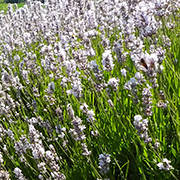
Lavender Hedging Guide
iOur Guide to All Lavender Hedge Plants
Lavender is an extremely popular hedging shrub, whose distinctive look can be easily identified, bringing classical English essence to a garden. Famous for the wonderful spires of blue, purple and white flowers and the delightful fragrance that they produce, Lavender is grown around the world for its beauty, but also for the harvesting of its essential oil and distinctive fragrance.
The sweet scent that Lavender produces, which can be described as pine-like and floral, comes from its attractive, aromatic grey-green foliage and its highly fragrant flower buds. Being evergreen, once the flowers are spent, Lavender still has its wonderful foliage to continue giving a pleasant aroma although it will die back somewhat during dormancy from late autumn through to early spring.Lavender Collections
Hedges Direct also has a series of Lavender collections featuring specially selected English and French Lavender varieties plus a mixed collection of both to offer flexibility of choice and versatility of look. Click on the link below to visit our Lavender Collections Page.
The History of Lavender
Lavender has been used throughout centuries and it is widely recognised for its fragrance, health benefits and of course its distinctive appearance. English Lavender (Lavandula angustifolia 'Munstead') was the basis of the England's lavender oil industry in the 1700's, and it's easy to see (or smell!) why with its incredible fragrance. A traditional favourite for the classic English cottage garden, Lavender 'Munstead' makes for a compact, hardy and easy to grow shrubby lavender hedge. Compared to the other main native 'Hidcote' variety of Lavender from the UK, English Lavender 'Munstead' has a softer and relatively pale shade of purple flowers, with a lighter colour of foliage.
1. Evergreen
Being evergreen, Lavender provides you with structure year round, however its foliage develops and then dies back on an almost perennial basis, coming out of dormancy and developing anew in the spring and providing a wonderful aroma until the autumn after which it becomes dormant once again.
2. Fragrant and Attractive
The leaves of any Lavender hedge plant are very heavily scented - really noticeable when you are taking them out of their pots and handling them. The distinctive scent that Lavender produces comes from the foliage and also directly from the flowers although it tends to be a combination of the two used to extract essential oil. The fragrant flowers and leaves also have a host of culinary uses from flavouring desserts to being used in place of Rosemary in savoury dishes and even flavouring and decorating the odd cocktail or two!
Lavender hedge plants are extremely attractive with their grey-green foliage and production of flowers in many different shades of blue, purple, pink and white. They can bring a cottage garden look to any space growing as happily in a pot as in the ground. However, it's when Lavender is planted as a low growing hedge that it can not only look truly stunning with its colourful and dynamic appearance, but it also exudes delicious fragrance as you brush past, creating a truly multi-sensory experience.
3. Wildlife Friendly
In summer, Lavender displays short cylindrical flower heads that radiate fantastic colours. You will enjoy these profuse flowers every bit as much as the butterflies and bees who adore the spectacular colours and when left unpruned, the flowers develop seeds that make a tasty treat for many garden birds.
4. Planting and Maintaining
These tough, drought tolerant plants are wonderful additions to any garden. The key with all Lavenders is to plant them in dry soil or in such a way that rainwater will run away from the roots (on little soil mounds). In their first year, they will need regular watering to ensure that they settle and develop well in their new home. However, other than in their first year, they need no additional watering unless they are planted in pots or we have a really long dry spell (imagine Lavender growing in Provence and you won't go far wrong). Maintenance is also simple - around August time each year and after flowering has finished, cut back the stems and foliage to around a third of the growth. This allows light into the plant and allows new shoots to form just before the plant goes into dormancy, ready to then develop in full the following year.
Why Choose Hedges Direct?
We supply a selection of Lavender hedging plants that produce flowers in different shades of blue, purple and white. Whether you prefer the intense indigo colour of Lavender Hidcote, or the subtle lilac tones of Dwarf Lavender or English Lavender, at Hedges Direct we have a selection of Lavender Hedge plants to choose from that are amongst the most popular varieties.
Don't forget, if you have any questions, our helpful sales team are only a phone call away on 01257 263 873.
If you are looking for a Lavender alternative, see our blog post for more information on Lavender Hedge Plants and their alternatives.
Show more >>>
Show less <<<


-Pale-Flowers.jpg)
-hedge-border.jpg)
-Flowers-Close-Up-2.jpg)
-Flowers-Close-Up.jpg)
-Single-Flower.jpg)












